Japan
Wood Products Prices
Dollar Exchange Rates of 10th
July
2019
Japan Yen 108.46
Reports From Japan
¡¡
Companies ease-up on expansion
The May monthly survey of Japan¡¯s machinery orders, an
indirect measure of private sector confidence for mediumterm
economic expansion, dipped the sharpest for the past
eight months. Machinery orders, while admittedly a
volatile data series, fell by almost 8% in May from the
previous month.
Global trade tensions are causing Japanese companies to
scale back on investment and there is doubt that domestic
demand can fill the gap in weakening export earnings.
This downturn in private sector spending undermines
prospects for achieving 2% inflation, the Bank of Japan¡¯s
target.
See: https://www.esri.cao.go.jp/en/stat/juchu/1905juchu-e.html
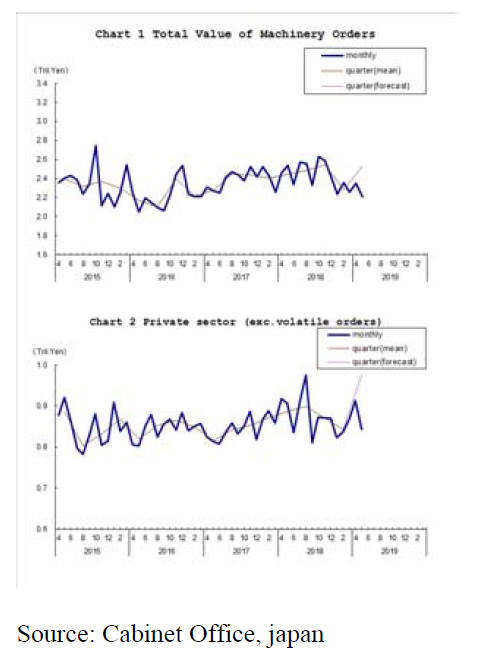
Election
The campaign for Japan's upper house election is
underway and voting will take place on 21 July.
Opposition parties, pointing to falling consumer
confidence, have strongly criticised the government after a
report from a government expert panel said the state
pension is insufficient and because of the government¡¯s
plan to raise the consumption tax this year.
This plan has raised alarm because previous tax hikes in
1997 and 2014 were followed by serious economic
downturns.
Long May holiday boosted spending
Household spending in Japan rose at the fastest pace in
four years in May. A recovery in private consumption is
seen as vital in Japan¡¯s fight against deflation. Household
spending grew 4% in May from a year earlier.
Behind the unexpected rise was the 10-day public holiday
in May. Data shows the growth in household spending was
driven mainly by accommodation bills, mobile phone
charges, transport costs and electricity charges.
Analysts point out that the risk is that consumer spending
will worsen as sentiment appears to be weakening because
wage growth has stalled and there is uncertainty over the
economic outlook. The planned consumption tax increase
set for October could drive up spending temporarily as
consumers try to beat the rise by buying early.

Yen still firm despite opening of US/China
trade talks
The Japanese Yen experienced an unusual level of
volatility in the first half of this year with a marked surge
in strength as the ¡®safe-haven¡¯ effect kicked in due to
rising risks in the global economy. However, by May the
risk notion had diminished and the yen/dollar exchange
rate steadied to move in a narrow range around 108 to the
dollar.
In June good data from the US lifted US stocks and the
likelihood of a cut in US interest rates further boosted US
stocks. Despite positive news on the US/China trade talks
the yen continues to be rather firm suggesting there is still
money seeking safety in the Japanese currency.
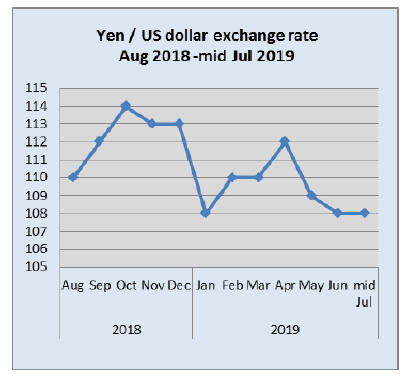
900 Japanese towns no longer viable by 2040
The data from the 2018 survey by the Japanese
government has shown that, excluding resident foreigners,
the population is now 124.8 million, the lowest since the
survey began in 1968.
With fewer than 1 million births in Japan for the third
straight year in 2018 the population dropped a record
433,239, the 10th straight year of decline.
The number of registered foreign residents, meanwhile,
increased to 2,667,199, up 169,543 from a year earlier,
with all 47 prefectures seeing a rise in the figure as
companies are turning to people from overseas to deal
with a severe labour shortage because of Japan's rapidly
aging population and declining birthrate.
People aged 65 or older accounted for 28% of the entire
population. The ratio of people aged between 15 and 64
who are regarded as working population was just over
50% and continues down.
The population decreased in 42 prefectures as the urban
drift accelerates with young people flocking to the big
cities. The most visible impact of the population decline is
in the countryside, with millions of empty homes and vast
areas of unworked farms. It has been estimated that at the
current rate of rural depopulation nearly 900 towns and
villages across Japan will no longer be viable by 2040.
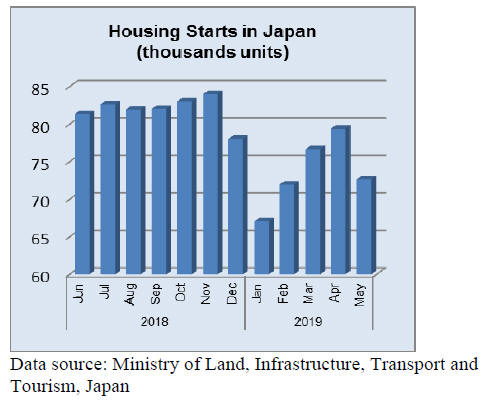
Import update
Wooden door imports
The value of Japan¡¯s May imports of wooden doors
(HS441820) was down 4% year on year but up 10% from
April. The top three shippers accounted for over 80% of
May imports with manufacturers in China accounting for
61% of May imports followed by the Philippines (18%)
and Malaysia (6%).
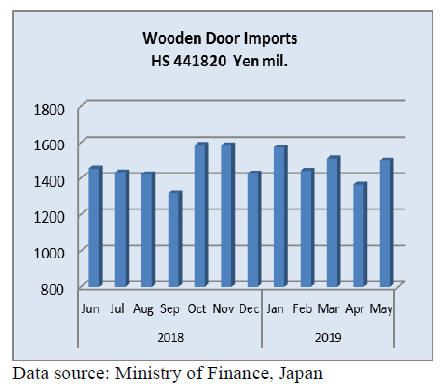
Wooden window imports
Japan¡¯s imports of wooden windows (HS441810) are not
very large but from the beginning of the year there has
been a steady rise in the value of imports. The value of
May imports were up 7% year on year and month on
month May imports rose by the same amount.
The three main shippers are China (39% of imports) the
US (27%) and the Philippines (20%). Sweden is a regular
supplier of windows to Japan and in May the value of
shipments added a further 8% to total imports.
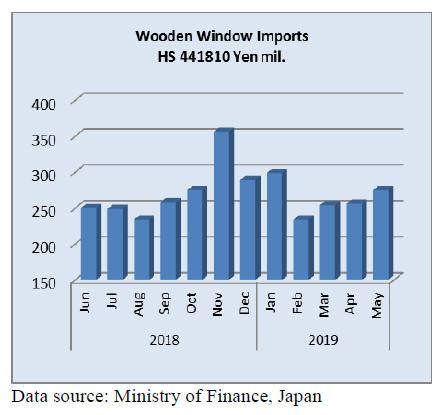
Assembled wooden flooring imports
A range of categories of assembled wooden flooring is
imported into Japan being in the range HS441871-79.
HS441875 accounted for 68% of May imports with China,
Indonesia, Thailand and Malaysia being the top shippers in
order of magnitude.
Imports of HS441879 accounted for a further 22% of May
import values with Indonesia, Germany and Thailand
being the top three shippers.
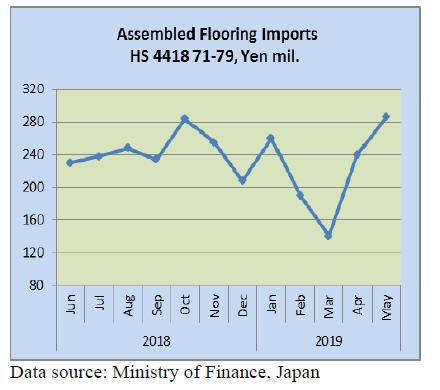
Plywood imports
There are major changes taking place in Japan¡¯s plywood
importing sector brought on by falling production in
Sarawak and to log supply issues in Indonesia.
The volume of May plywood imports dropped a massive
37% year on year, imports were also down 27% from
April. The Biggest losses were recorded in shipments
from Malaysia which were down 34% year on year and
also -34% month on month.
Shipments from Indonesia dropped 40% year on year in
May and were down 26% compared to the volume of
April imports. China ships some plywood to Japan but is
not a major supplier. The volume of May shipments from
China dropped 20% year on year but rose 10% month on
month.
As in previous months, imports were dominated by HS
441231 accounting for 88% of all May imports. HS441233
and 34 contributed 5% each with another 2% being
HS441239.

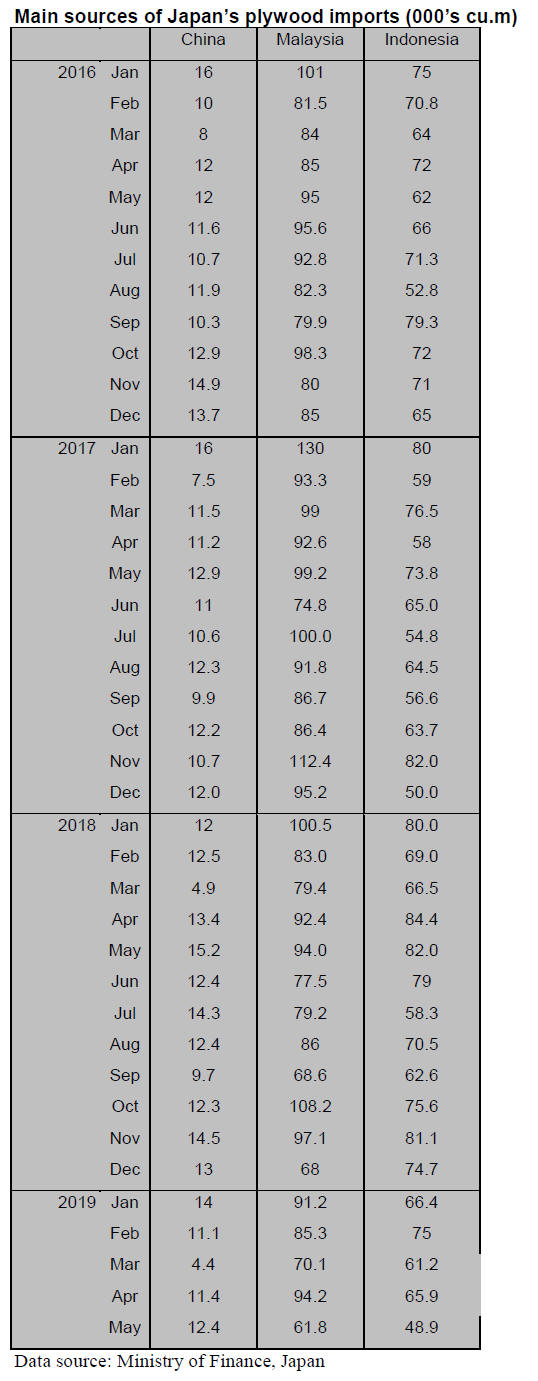
Tropical log imports forecast to drop
further in 2019
The Japan Lumber Journal (vol. 60 No. 13J) has reported
that, at its most recent meeting, the Japan Southsea
Lumber Conference discussed the issue of declining
supply of and weakening demand for tropical logs in
Japan.
The JLJ says Japan¡¯s imports of logs from PNG in the first
four months of 2019 increased mainly to substitute for
logs that were coming from Sabah before the introduction
of the log export ban.
The meeting heard that the current government in PNG
has a policy of encouraging domestic processing and that
this may affect future supplies of logs to Japan.
The meeting learned that some Japanese companies are
trying to expand veneer imports from Sabah while others
are testing imports of plantation timbers such as acacia and
falcata.
For 2019 the delegates forecast the supply of tropical
timber in 2019 at around 140,000 cubic metres, almost
10% less than in 2018.
Trade news from the Japan Lumber Reports (JLR)
The Japan Lumber Reports (JLR), a subscription trade
journal published every two weeks in English, is
generously allowing the ITTO Tropical Timber Market
Report to reproduce news on the Japanese market
precisely as it appears in the JLR.
For the JLR report please see:
http://www.nmokuzai.
com/modules/general/index.php?id=7
Performance of building material trading firms
Sales of four building materials trading firms, Itochu
Kenzai Corporation, SMB Kenzai Co., Ltd, Sojitz
Building materials Co., Ltd. and Tomen Materia
Corporation and Sumitomo Forestry for the term ended
March 2019 are almost unchanged from the last term but
the profit declined.
The largest reason is soaring cost of imported hardwood
plywood in the second half of the year and they failed to
pass higher cost onto sales prices by weak market. Also
new housing starts decreased by 2.3% so sales of building
materials were slow.
Total sales by five companies are 1,220.5 billion yen,
2.3% more than the last term. Ordinary profit increased by
three billion yen is by large increase of Sumitomo Forestry
and that of remaining four companies is 11.2% less than
last term.
Sales increased by 27.7 billion yen out of which plywood
business was 16.3 billion yen (2.4 billion yen of domestic
and 13.9 billion yen of imported plywood). Non-wood
materials were 9.9 billion yen. Construction and materials
were 3.2 billion yen. Wood products were 2.6 billion yen
and house appliances were 300 million yen.
Almost half of increased sales were imported plywood.
First half was booming then the cost of thin plywood and
floor base soared in the second half and they failed to pass
the high cost onto sales prices so they suffered large loss
to wipe out profit in the first half.
Construction and related materials were good.
Renovation
business did not grow. Home appliance business is flat.
In sales, Sumitomo Forestry is the top with 378 billion yen
and SMB Kenzai is the second with 338 billion yen.
Itochu Kenzai was the third with 308 billion yen.
Sumitomo Forestry shifted overseas manufacturing
business to the building materials division and New
Zealand manufacturing business transferred tree plantation
business to subsidiary company and 8.4 billion yen of
profit by transfer is listed as ordinary profit, which pushed
the profit up.
Itochu Kenzai made profit in all the business but plywood
so total profit decreased but three subsidiary companies
registered sales of 28.6 billion yen with ordinary profit of
one billion yen so consolidated sales are 330 billion yen
with current income of 2.9 billion yen, which are the
record high.
Marutama starts Hokkaido fir plywood
Marutama Plywood (Abashiri, Hokkaido) has finished test
manufacturing of local fir plywood (4 mm, 4x8) and will
take orders as soon as manufacturing line is maintained
properly hopefully sometime within this year. It also plans
to manufacture plywood with unused local hardwood logs
(4 mm, 3x6).
Japanese plywood manufacturers are developing nonstructural
plywood and this is the first case of medium
thick panel made by all local Hokkaido species.
The trial product is three plied fir plywood. This size of 4
mm 4x8 has been used as base of decorative plywood,
which is unique size of South Sea hardwood plywood. It is
used as interior finishing panel of 2x8 with sliced veneer
cover or printed surface. It will manufacture 4 mm 3x6
local white birch plywood.
Trial products are 100% birch three plied panel and face
and back with birch and larch core.
In Hokkaido, stock of hardwood is 385 million cbms but
only 576,000 cbms are harvested, which is 26% of total
domestic hardwood.
Actually Hokkaido hardwood is only used for high quality
products like furniture and sliced veneer so development
of unused hardwood is Hokkaido¡¯ challenge for many
years and now Marutama stepped up to try manufacturing
birch plywood.
Marutama has several log yards, where logs are sorted by
use like lumber, plywood and wood chip. Sorted logs are
sent to plywood mill. So far, logs are mainly larch and fir
but now unused hardwood species are gathered in log
yards.
The largest reason of developing unused specie is
declining trend of South Sea hardwood plywood supply
and demand of floor base and concrete forming panel
relied on South Sea hardwood plywood and now Japanese
mills need to find substituting source for these items.
Marutama has been manufacturing structural plywood
with local larch but it also has been manufacturing nonstructural
plywood for floor base, sheathing panel and
concrete forming at the second plant.
South Sea logs and lumber
South Sea log import for the first four months were 45,143
cbms, about 2.2 times more than the same period of last
year. Domestic plywood manufacturers are able to build
up two to three months log inventories.
Orders on laminated free board were active in April and
May due to dropping inventories while the supply is
recovering since late June. Indonesian suppliers are
anxious to export due to weak Indonesian currency.
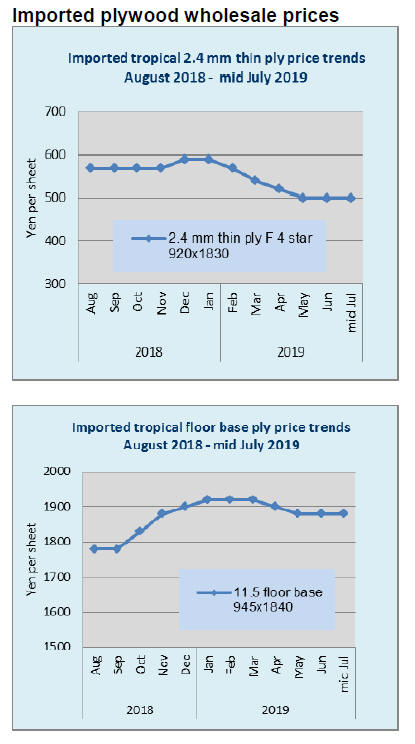
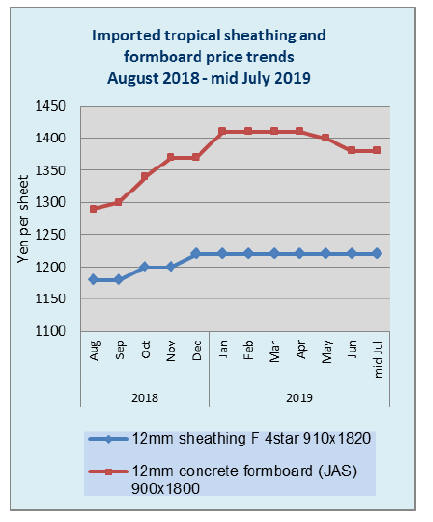
|